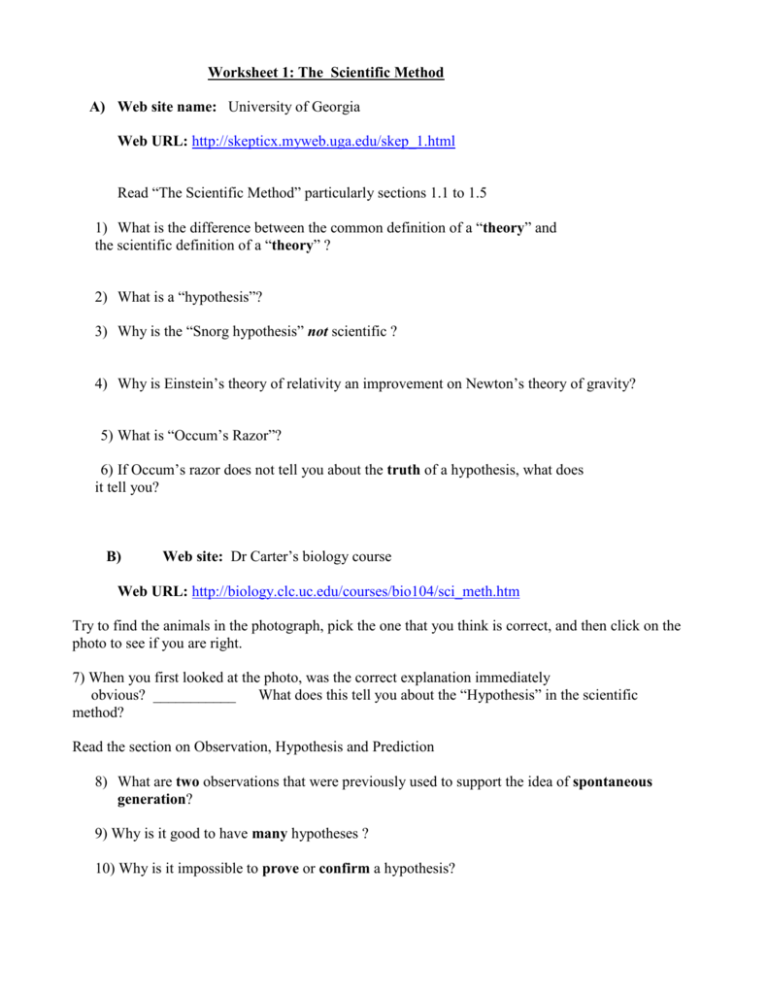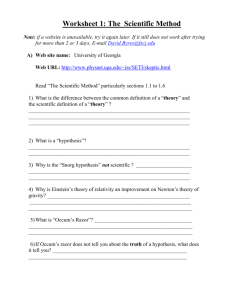Worksheet 1: The Scientific Method
advertisement

Worksheet 1: The Scientific Method A) Web site name: University of Georgia Web URL: http://skepticx.myweb.uga.edu/skep_1.html Read “The Scientific Method” particularly sections 1.1 to 1.5 1) What is the difference between the common definition of a “theory” and the scientific definition of a “theory” ? 2) What is a “hypothesis”? 3) Why is the “Snorg hypothesis” not scientific ? 4) Why is Einstein’s theory of relativity an improvement on Newton’s theory of gravity? 5) What is “Occum’s Razor”? 6) If Occum’s razor does not tell you about the truth of a hypothesis, what does it tell you? B) Web site: Dr Carter’s biology course Web URL: http://biology.clc.uc.edu/courses/bio104/sci_meth.htm Try to find the animals in the photograph, pick the one that you think is correct, and then click on the photo to see if you are right. 7) When you first looked at the photo, was the correct explanation immediately obvious? ___________ What does this tell you about the “Hypothesis” in the scientific method? Read the section on Observation, Hypothesis and Prediction 8) What are two observations that were previously used to support the idea of spontaneous generation? 9) Why is it good to have many hypotheses ? 10) Why is it impossible to prove or confirm a hypothesis? 11) Explain the difference between inductive and deductive reasoning, and give your own example of each: 12) What is a “controlled experiment”? C) Web page: NASA Web URL: http://science.nasa.gov/headlines/y2002/15may_maggrav.htm?list740511 Read “Sowing seeds in a magnetic field” 13) Why must there be “more to it” than the idea that plants grow towards light? 14) Give your own example of a plant behavior that is affected by gravity: 15) What are the two possibilities for how plants detect gravity? 16) Explain why the shuttle experiment will use “artificial gravity” produced by magnets. 17) Why is this experiment conducted in the dark? To test different explanations, or hypotheses, scientists do an experiment. D) Web page: Genentech Web URL: http://www.accessexcellence.org/RC/AB/BC/Elegant_Experiments.html Read the section on the Scientific Method 18) Explain why cause and effect are important in the scientific method: Click on “Experiments that inspire” at the bottom of the page. Read the section on the HersheyChase experiment. 19) 20) When were “bacterial viruses” first discovered? What chemical is found in protein but not in DNA ? Click on the Graphics Gallery : The Hershey-Chase Experiment 21) What was the conclusion from this experiment ? (use your own words) Go to: http://www.accessexcellence.org/RC/AB/BC/Spontaneous_Generation.html 22) In Francesco Redi’s experiments from 1668 why did maggots only appear in the open flask ? 23) Why did microorganisms like bacteria grow in the chicken broth that John Needham had boiled ? 24) How was Pasteur’s experiment an improvement on John Needham’s experiment ? 25) Can you think of any common grocery items that are “pasteurized”? 26) Use the example of spontaneous generation to explain how a hypothesis can be proved wrong, but cannot be proved right : E) Web page: State University of New York Web URL: http://ublib.buffalo.edu/libraries/projects/cases/coots/coots.html 27) What is the hypothesis here? Click on “Go to Parts II-V” 28) Why did dyeing the plumage of the chicks not work well? 29) What three data did the scientists decide to compare? 30) Click on “Go to Figure 2” and summarize the results: 31) Do the results support the original hypothesis? Explain your answer:










